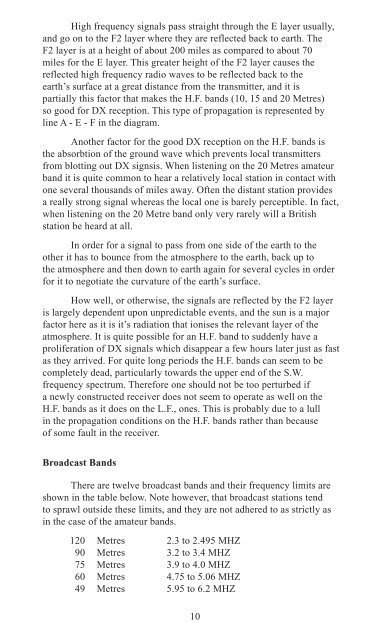Solid State Shortwave Receivers For Beginners - The Listeners Guide
Solid State Shortwave Receivers For Beginners - The Listeners Guide
Solid State Shortwave Receivers For Beginners - The Listeners Guide
You also want an ePaper? Increase the reach of your titles
YUMPU automatically turns print PDFs into web optimized ePapers that Google loves.
High frequency signals pass straight through the E layer usually,<br />
and go on to the F2 layer where they are reflected back to earth. <strong>The</strong><br />
F2 layer is at a height of about 200 miles as compared to about 70<br />
miles for the E layer. This greater height of the F2 layer causes the<br />
reflected high frequency radio waves to be reflected back to the<br />
earth’s surface at a great distance from the transmitter, and it is<br />
partially this factor that makes the H.F. bands (10, 15 and 20 Metres)<br />
so good for DX reception. This type of propagation is represented by<br />
line A - E - F in the diagram.<br />
Another factor for the good DX reception on the H.F. bands is<br />
the absorbtion of the ground wave which prevents local transmitters<br />
from blotting out DX signsis. When listening on the 20 Metres amateur<br />
band it is quite common to hear a relatively local station in contact with<br />
one several thousands of miles away. Often the distant station provides<br />
a really strong signal whereas the local one is barely perceptible. In fact,<br />
when listening on the 20 Metre band only very rarely will a British<br />
station be heard at all.<br />
In order for a signal to pass from one side of the earth to the<br />
other it has to bounce from the atmosphere to the earth, back up to<br />
the atmosphere and then down to earth again for several cycles in order<br />
for it to negotiate the curvature of the earth’s surface.<br />
How well, or otherwise, the signals are reflected by the F2 layer<br />
is largely dependent upon unpredictable events, and the sun is a major<br />
factor here as it is it’s radiation that ionises the relevant layer of the<br />
atmosphere. It is quite possible for an H.F. band to suddenly have a<br />
proliferation of DX signals which disappear a few hours later just as fast<br />
as they arrived. <strong>For</strong> quite long periods the H.F. bands can seem to be<br />
completely dead, particularly towards the upper end of the S.W.<br />
frequency spectrum. <strong>The</strong>refore one should not be too perturbed if<br />
a newly constructed receiver does not seem to operate as well on the<br />
H.F. bands as it does on the L.F., ones. This is probably due to a lull<br />
in the propagation conditions on the H.F. bands rather than because<br />
of some fault in the receiver.<br />
Broadcast Bands<br />
<strong>The</strong>re are twelve broadcast bands and their frequency limits are<br />
shown in the table below. Note however, that broadcast stations tend<br />
to sprawl outside these limits, and they are not adhered to as strictly as<br />
in the case of the amateur bands.<br />
120 Metres 2.3 to 2.495 MHZ<br />
90 Metres 3.2 to 3.4 MHZ<br />
75 Metres 3.9 to 4.0 MHZ<br />
60 Metres 4.75 to 5.06 MHZ<br />
49 Metres 5.95 to 6.2 MHZ<br />
10

















